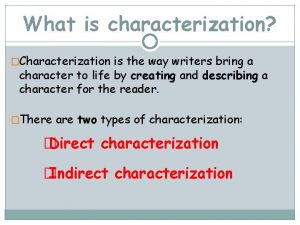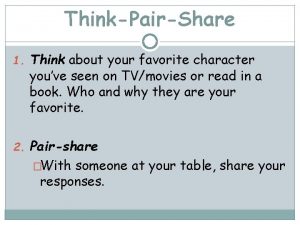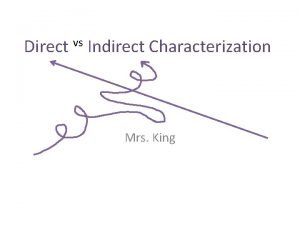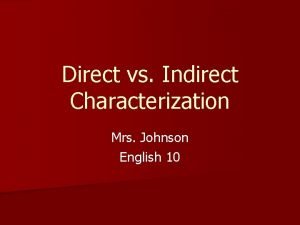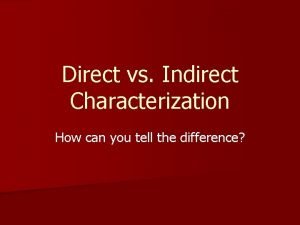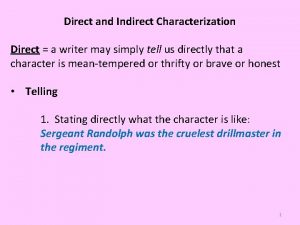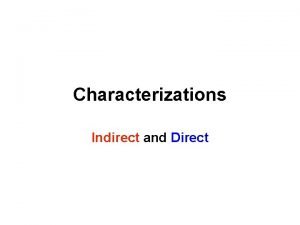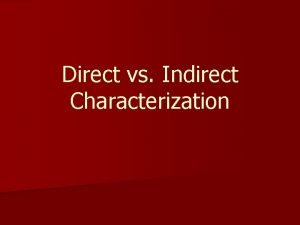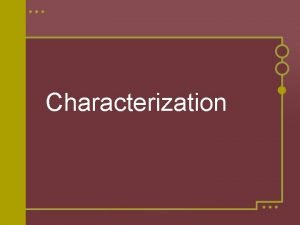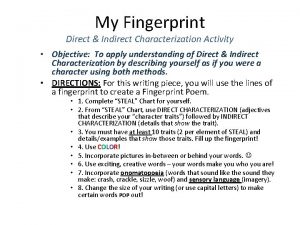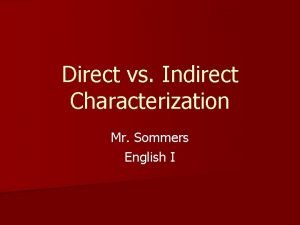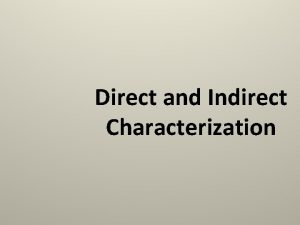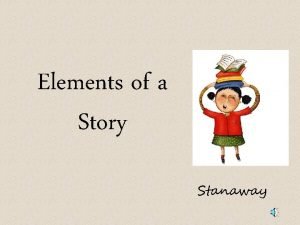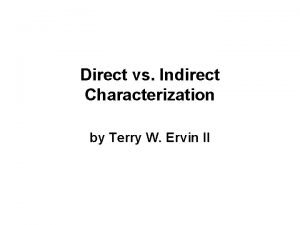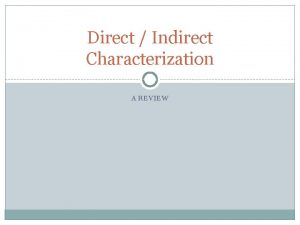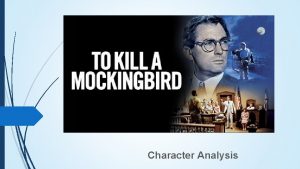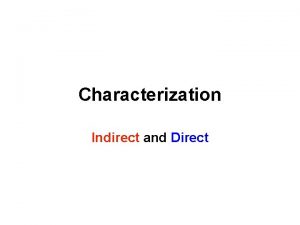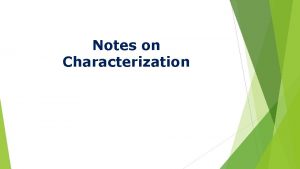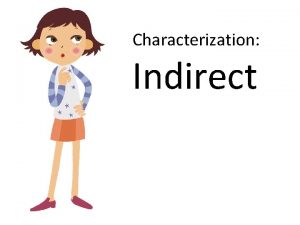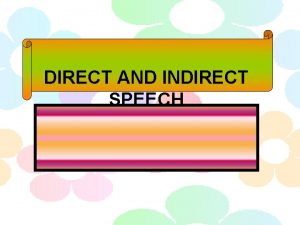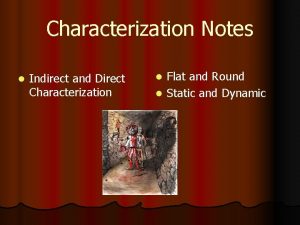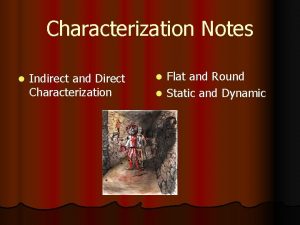Characterization Direct Indirect n The writer can let























- Slides: 23

Characterization

Direct & Indirect n The writer can let us know what a character is like through direct and indirect characterization. n Direct characterization is when a writer simply tells the reader what a character’s personality is like n Example: "Mrs. Freeman could never be brought to admit herself wrong on any point. "—Flannery O'Connor, "Good Country People"

Indirect Characterization n In indirect characterization the writer shows you what the character is like by revealing: n appearance n actions n words n thoughts & feelings n reactions of other characters

Appearance n We often infer a lot about characters from the clothes they wear, their facial features, their body language, and their mannerisms. n Example: "The Baker, who was an older man with a thick neck, listened without saying anything when she told him the child would be eight years old next Monday. The baker wore a white apron that looked like a smock. Straps cut under his arms, went around in back and then to the front again, where they were secured under his heavy waist. He wiped his hands on his apron as he listened to her. He kept his eyes down on the photographs and let her talk. "— Raymond Carver, "A Small, Good Thing"

Action n Do you know the expression, “Actions speak louder than words”? Much of what we learn about characters is revealed to us through what they do. n Example: "He would hang around our place on Saturdays, scornful of whatever I was doing but unable to leave me alone. I couldn't be on the swing without him wanting to try it, and if I wouldn't give it up he came and pushed me so that I went crooked. He teased the dog. He got me into trouble— deliberately and maliciously, it seemed to me afterward—by daring me to do things I wouldn't have thought of on my own: digging up the potatoes to see how big they were when they were still only the size of marbles, and pushing over the stacked firewood to make a pile we could jump off. "—Alice

Words n We often get to know characters because of what they say to each other. n "Unable to contain herself, [Mrs. Bennet] began scolding one of her daughters. 'Don't keep coughing so, Kitty, for heaven's sake! Have a little compassion on my nerves. You tear them to pieces. '"—Jane Austin, Pride and Prejudice

Thoughts and Feelings n When an author lets us get inside the mind of a character, we can often learn a great deal about him or her. n Example: "I didn't come to Utah to be the same boy I'd been before. I had my own dreams of transformation, Western dreams, dreams of freedom and dominion and taciturn self-sufficiency. The first thing I wanted to do was change my name. A girl named Toby had joined my class before I left Florida, and this had caused both of us scalding humiliation. "I wanted to call myself Jack, after Jack London. I believed that having his name would charge me with some of the strength and competence inherent in my idea of him. The odds were good that I'd never have to share a classroom with a girl named Jack. And I liked the sound. Jack Wolff. "—Tobias Wolff, This

Other Character’s Comments or Reactions n Sometimes other characters will tell us something useful about the character we’re reading about. n Example: "No respect at all was shown him in the department. The porters, far from getting up from their seats when he came in, took no more notice of him than if a simple fly had flown across the reception room. "—Nikolai

Which method of characterization is being used? Org the ugly was usually angry. q. Words q. Actions q. Appearance q. Thoughts and feelings q. Other characters’ comments or reactions q. Direct comments by narrator

Which method of characterization is being used? He stood up stiffly and glared at the sky. q. Words q. Actions q. Appearance q. Thoughts and feelings q. Other characters’ comments or reactions q. Direct comments by narrator

Which method of characterization is being used? He raised his slimy fists and beat them against his huge, hairy chest. q. Words q. Actions q. Appearance q. Thoughts and feelings q. Other characters’ comments or reactions q. Direct comments by narrator

Which method of characterization is being used? “I feel just like a dark sky!” Org shouted. q. Words q. Actions q. Appearance q. Thoughts and feelings q. Other characters’ comments or reactions q. Direct comments by narrator

Which method of characterization is being used? “I haven’t seen him this angry in a long time, ” said Org’s wife to the cook. q. Words q. Actions q. Appearance q. Thoughts and feelings q. Other characters’ comments or reactions q. Direct comments by narrator

Which method of characterization is being used? Org leaned against a tree trunk and thought about how mean and ugly and mad he felt. q. Words q. Actions q. Appearance q. Thoughts and feelings q. Other characters’ comments or reactions q. Direct comments by narrator

Which method of characterization is being used? Suddenly, he wrapped his arms around the tree. He pulled and tore at it until it ripped out of the earth, roots and all. q. Words q. Actions q. Appearance q. Thoughts and feelings q. Other characters’ comments or reactions q. Direct comments by narrator

Which method of characterization is being used? All the gentle woodland creatures in the forest shook their heads sadly at Org and his hateful ways. q. Words q. Actions q. Appearance q. Thoughts and feelings q. Other characters’ comments or reactions q. Direct comments by narrator

Practice n Read the following passage and think about how the author uses each type of characterization. n "Lincoln's shock of black hair, brown furrowed face, and deepset eyes made him look older than his fifty-one years. He was a familiar figure to almost everyone in Springfield, as was his singular way of walking, which gave the impression that his long, gaunt frame needed oiling. He plodded forward in an awkward manner, hands hanging at his sides or folded behind his back. His step had no spring. . . "His features, even supporters conceded, were not such 'as belong to a handsome man. ' In repose, his face was '[overspread] with sadness, ' the reporter Horace White noted. . . Yet when Lincoln began to speak, White observed, 'this expression of sorrow dropped from him instantly. His face lighted up with a winning smile, and where I had a moment before seen only leaden sorrow I now beheld keen intelligence, genuine kindness of heart, and the promise of true friendship. '"—Doris Kearns Goodwin, Team of

Practice Method of Characterization Evidence What does the character look like? Lincoln has black hair and a wrinkled face. He looks older than he is, and he appears deeply sad until he starts talking. He has a particular, awkward way of walking. How does the character behave towards others? How do others behave toward the character? He is warm and friendly towards others, and others—or at least this reporter—seem to react with fondness and admiration toward him. What does the character seem to care about? Lincoln seems to care about and thrive on his interactions with others; he seems less concerned with his physical appearance. What adjectives does the author use to describe the character's personality? The author quotes the reporter as saying when Lincoln interacts with people, he loses his sorrowful appearance and becomes bright with "a winning smile, " "keen intelligence, " "genuine kindness, " and "true friendship. " What does the character think or say? I'm not sure yet what he thinks or says.

Protagonist/Antagonist • It is easy to think of the protagonist and antagonist as the "good guy" and the "bad guy, " respectively. This is often true. • However, technically, the protagonist is the leading or most important character in a work. The plot of the story is often written in the protagonist's point of view. The antagonist is simply the character who opposes him or her. Can you think of a book/film/play with a bad guy for a protagonist? • Consider the story The Three Little Pigs. In the original story, the three pigs are the protagonists and the wolf is the antagonist. A new book titled The Real Story of The Three Little Pigs is written in the wolf's point of view and he becomes the protagonist and the pigs are the antagonists.

Round/Flat Characters n Characters that are described in depth, with many details, are well-rounded characters. They are called round characters. If you're reading a story and you feel like you know a character extremely well, then most likely the character is round. The main character in a story is almost always round, but there are exceptions.

Round/Flat Characters n Characters that are not described well, that you're not given much information about, are flat characters. Consider a drawing: a three dimensional drawing gives more detail than a one dimensional drawing. If you draw a flat picture of a house, for example, you can only see one side of it. You cannot see three of the four sides. This is how a flat character is; you can only see a few characteristics of the character. There are many things you cannot "see, " or many details you are not given by the author.

Static/Dynamic Characters • The key word when dealing with the difference between static and dynamic characters is "change. " The type of change, though, is specific. We are only concerned with changes that occur within the character. These would include a major change in their personality, or a change in their outlook on life. • In order for a character to be considered a static character, the character must remain basically the same throughout the entire story. • A dynamic character is a character that undergoes an internal change sometime between the beginning and end of the story. The change in the character is usually crucial to the story itself.

Static/Dynamic Characters n A good way of remembering the difference between static and dynamic characters is to think about static electricity and dynamite. n A shock from static electricity is a very minor occurrence. The amount of energy transferred is minimal. So too, static characters change very little n Explosion of a stick of dynamite, on the contrary, is a huge release of energy. Accordingly, dynamic characters change a great deal over the course of a story.
 Direct characterization examples
Direct characterization examples What is direct and indirect characterization
What is direct and indirect characterization What is direct characterization
What is direct characterization John 10:22-28
John 10:22-28 What is characterization
What is characterization Whats direct characterization
Whats direct characterization Direct vs indirect characterization
Direct vs indirect characterization Indirect characterization define
Indirect characterization define What is indirect characterization
What is indirect characterization Direct and indirect characterization
Direct and indirect characterization Direct and indirect characterization worksheet
Direct and indirect characterization worksheet Methods of indirect characterization
Methods of indirect characterization Indirect characterizations
Indirect characterizations Characterization direct and indirect
Characterization direct and indirect What is direct characterization
What is direct characterization Whats characterization
Whats characterization Direct and indirect characterization activities
Direct and indirect characterization activities Thomas putnam indirect characterization
Thomas putnam indirect characterization Direct vs indirect characterization
Direct vs indirect characterization Direct and indirect characterization quiz
Direct and indirect characterization quiz Direct and indirect characterization
Direct and indirect characterization Indirect characterization paragraph example
Indirect characterization paragraph example Direct vs. indirect characterization
Direct vs. indirect characterization Never let me go ruth
Never let me go ruth




